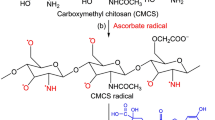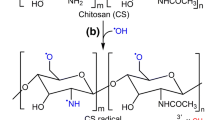Abstract
The aim of this study was to investigate the possibility of immobilizing peptoid on chitosan film in order to generate new active material. Chitosan films have been grafted for the first time with short-length peptoid oligomers displaying antioxidant activities. The antioxidant activity of the selected peptoids was initially investigated with the DPPH assay and hydroxyl radical procedure. The metal chelating capacity of peptoids was also evaluated prior to their covalent attachment to chitosan. The benefit of chitosan functionalization with respect to its intrinsic antioxidant properties was finally evaluated in the present study. Interestingly, an increase of up to 90 % of the antioxidant activity of chitosan was observed.





Similar content being viewed by others
References
Morales González, J.A. (2013). Oxidative stress and chronic degenerative diseases—a role for antioxidants, ed. J.A. Morales González, InTech, Croatia. pp. 1-485.
Di Bernardini, R., Harnedy, P., Bolton, D., Kerry, J., O’Neill, E., Mullen, A. M., & Hayes, M. (2011). Antioxidant and antimicrobial peptidic hydrolysates from muscle protein sources and by-products. Food Chem., 124, 1296–1307.
Alvarez, I., Niemira, B. A., Fan, X., & Sommers, C. H. (2007). Inactivation of Salmonella enteritidis and Salmonella senftenberg in liquid whole egg using generally recognized as safe additives, ionizing radiation, and heat. J. Food Protect., 174, 1402–1409.
Siripatrawan, U., & Harte, B. R. (2010). Physical properties and antioxidant activity of an active film from chitosan incorporated with green tea extract. Food Hydrocolloids., 24, 770–775.
Mati-Baouche, N., Elchinger, P. H., De Baynast, H., Pierre, G., Delattre, C., & Michaud, P. (2014). Chitosan as an adhesive. Eur. Polym. J., 60, 198–212.
Kumar, M. N. V. R., Muzzarelli, R. A. A., Muzzarelli, C., Sashiwa, H., & Domb, A. J. (2004). Chitosan chemistry and pharmaceutical perspectives. Chem. Rev., 104, 6017–6084.
Falguera, V., Quintero, J. P., Jiménez, A., Muñoz, J. A., & Ibarz, A. (2011). Edible films and coatings: structures, active functions and trends in their use. Trends Food Sci Tech., 22, 292–303.
Simon, R. J., Kania, R. S., Zuckermann, R. N., Huebner, V. D., Jewell, D. A., Banville, S., Ng, S., Wang, L., Rosenberg, S., Marlowe, C. K., Spellmeyer, D. C., Tan, R., Frankel, A. D., Santi, D. V., Cohen, F. E., & Bartlett, P. A. (1992). Peptoids: a modular approach to drug discovery. Proc. Natl. Acad. Sci. U.S.A., 89, 9367–9371.
Zuckermann, R. N. (2011). Peptoid origins. Biopolymers., 96, 545–555.
Miller, S. M., Simon, R. J., Ng, S., Zuckermann, R. N., Kerr, J. M., & Moos, W. H. (1994). Proteolytic studies of homologous peptide and N-substituted glycine peptoid oligomers. Bioorg. Med. Chem. Lett., 4, 2657–2662.
Fowler, S. A., & Blackwell, H. E. (2009). Structure-function relationships in peptoids: Recent advances toward deciphering the structural requirements for biological function. Org. Biomol. Chem., 7, 1508–1524.
Szekely, T., Caumes, C., Roy, O., Faure, S., & Taillefumier, C. (2013). α-Peptoïdes et composés apparentés: synthèse et contrôle de la conformation. C. R. Chimie., 16, 318–330.
Yoo, B., & Kirshenbaum, K. (2008). Peptoid architectures: elaboration, actuation, and application. Curr. Opin. Chem. Biol., 12, 714–721.
Gangloff, N., Ulbricht, J., Lorson, T., Schlaad, H., & Luxenhofer, R. (2016). Peptoids and polypeptoids at the frontier of supra- and macromolecular engineering. Chem. Rev., 116, 1753–1802.
Bailey, M. A., Ingram, M. J., & Naughton, D. P. (2004). A novel anti-oxidant and anti-cancer strategy: a peptoid anti-inflammatory drug conjugate with SOD mimic activity. Biochem. Biophys. Res. Commun., 317, 1155–1158.
Fisher, A. E. O., Maxwell, S. C., & Naughton, D. P. (2003). Catalase and superoxide dismutase mimics for the treatment of inflammatory diseases. Inorg. Chem. Commun., 6, 1205–1208.
Fisher, A. E. O., & Naughton, D. P. (2004). Metal ion chelating peptoids with potential as anti-oxidants: complexation studies with cupric ions. J. Inorg. Biochem., 98, 343–346.
Zhang, Y., Li, L., Yu, C., & Hei, T. (2011). Chitosan-coated polystyrene microplate for covalent immobilization of enzyme. Anal. Bioanal. Chem., 401, 2311–2317.
Hjelmgaard, T., Faure, S., Caumes, C., De Santis, E., Edwards, A. A., & Taillefumier, C. (2009). Convenient solution-phase synthesis and conformational studies of novel linear and cyclic α, β-alternating peptoids. Org. Lett., 11, 4100–4103.
De Santis, E., Hjelmgaard, T., Caumes, C., Faure, S., Alexander, B. D., Holder, S. J., Siligardi, G., Taillefumier, C., & Edwards, A. A. (2012). Effect of capping groups at the N- and C-termini on the conformational preference of α, β-peptoids. Org. Biomol. Chem., 10, 1108–1122.
Ho, M.-H., Wang, D.-M., Hsieh, H.-J., Liu, H.-C., Hsien, T.-Y., Lai, J.-Y., & Hou, L.-T. (2005). Preparation and characterization of RGD-immobilized chitosan scaffolds. Biomat., 26, 3197–3206.
Delattre, C., Pierre, G., Gardarin, C., Traikia, M., Elboutachfaiti, R., Isogai, A., & Michaud, P. (2015). Antioxidant activities of a polyglucuronic acid sodium salt obtained from TEMPO-mediated oxidation of xanthan. Carbohyd Polym., 116, 34–41.
Dinis, T. C. P., Madeira, V. M. C., & Almeida, L. M. (1994). Action of phenolic derivatives (acetaminophen, salicylate, and 5-aminosalicylate) as inhibitors of membrane lipid peroxidation and as peroxyl radical scavengers. Arch. Biochem. Biophys., 315, 161–169.
Rice-Evans, C. A., Miller, N. J., & Paganga, G. (1996). Structure-antioxidant activity relationships of flavonoids and phenolic acids. Free Radic. Biol. Med., 20, 933–956.
Maulucci, N., Izzo, I., Bifulco, G., Aliberti, A., De Cola, C., Comegna, D., Gaeta, C., Napolitano, A., Pizza, C., Tedesco, C., Flot, D., & De Riccardis, F. (2008). Synthesis, structures, and properties of nine-, twelve-, and eighteen-membered N-benzyloxyethyl cyclic α-peptoids. Chem. Commun., 33, 3927–3929.
De Cola, C., Licen, S., Comegna, D., Cafaro, E., Bifulco, G., Izzo, I., Tecilla, P., & De Riccardis, F. (2009). Size-dependent cation transport by cyclic alpha-peptoid ion carriers. Org. Biomol. Chem., 7, 2851–2854.
De Cola, C., Fiorillo, G., Meli, A., Aime, S., Gianolio, E., Izzo, I., & De Riccardis, F. (2014). Gadolinium-binding cyclic hexapeptoids: synthesis and relaxometric properties. Org. Biomol. Chem., 12, 424–431.
Friedman, M., & Juneja, V. K. (2010). Review of antimicrobial and antioxidative activities of chitosans in food. J. Food Prot., 73, 1737–1761.
Khare, A. K., Biswas, A. K., & Sahoo, J. (2014). Comparison study of chitosan, EDTA, eugenol and peppermint oil for antioxidant and antimicrobial potentials in chicken noodles and their effect on colour and oxidative stability at ambient temperature storage. LWT - Food Sci Technol., 55, 286–293.
Liu, J., Wen, X.-Y., Lu, J.-F., Kan, J., & Jin, C.-H. (2014). Free radical mediated grafting of chitosan with caffeic and ferulic acids: Structures and antioxidant activity. Int. J. Biol. Macromol., 65, 97–106.
Acknowledgments
This work received sponsorship by the French government under the “Investissements d'avenir” research program via the IMobS3 Laboratory of Excellence (ANR-10-LABX-16-01), by the European Union under the EU Regional competitiveness and employment program 2007–2013 (ERDF-Auvergne region), and by the Auvergne region (CPER “axe Innovapole”).
Author information
Authors and Affiliations
Corresponding author
Rights and permissions
About this article
Cite this article
Elchinger, PH., Delattre, C., Faure, S. et al. Antioxidant Activities of Peptoid-Grafted Chitosan Films. Appl Biochem Biotechnol 181, 283–293 (2017). https://doi.org/10.1007/s12010-016-2212-7
Received:
Accepted:
Published:
Issue Date:
DOI: https://doi.org/10.1007/s12010-016-2212-7




